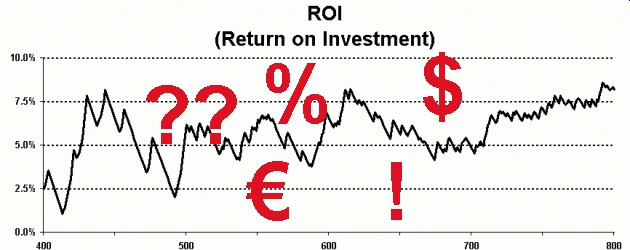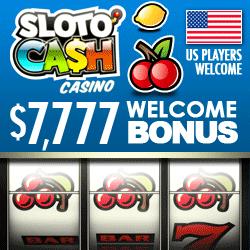Recommended Poker Room
What is the achievable ROI (return on investment) in Sit and Go’s? What ROI should a good player expect while playing these poker tournaments? These are questions that are often asked by SNG players in poker forums. It is difficult to answer these questions because results in online poker have a very high variance and the game and the opponents are constantly changing. In this article, we first present you the facts that affect the expected ROI per buy-in and at the end we will give a very rough estimate for the expected profit (ROI) for good players as a function of the SNG buy-in.
Sample Size and Variance
The variance in SNGs is enormous. So you need to have a large sample size when calculating ROI. In 1,000 played SNGs the standard deviation is still 5%. This means that in 32% of cases, the achievable ROI will differ from the measured ROI by more than 5% (up or down). But only few poker players play more than 1,000 or even more than 5,000 games at the same buy-in and in a short time frame. Most players will need a lot of time (and opponents change in the course of time) or they move up in limits as soon as they have the bankroll for the next higher buy-in.
ROI of Average Players and of Winning Players
The question about the possible or expected ROI per limit can be answered simply: The expected ROI for an average player is -9.1%. Due to the fees for playing tournaments (the rake), in a 10-handed SNG with a buy-in of $10 +$1, the average player makes a loss of $1, resulting in a negative ROI of minus 9.1%. In reality, the expected return on investment for an average player is even lower: good players usually play six or more tables at the same time, so that at each table there might be sitting three winning players, while only one in ten players makes a profit on average.
Multitabling and Hourly Rate
As mentioned already, most strong players play on multiple tables at the same time. The professional poker player Thomas Boekoff alias “Boku87” manages to play up to 50 tables simultaneously. The goal of grinders such as Boku87 is not to maximize their ROI, but to earn a lot of money per hour of play and thus to maximize their hourly wage (hourly rate). The measured ROI of such players is therefore lower than the ROI they could achieve if they would play only a few tables at a time.
Moving Up in Limits
Very good players increase their bankroll fast and will then try to move up to higher buy-ins in order to increase their hourly wage. A top player might prefer for example to play $100 SNG’s with a ROI of 5% instead of playing $50 SNG’s with a ROI of 8% as this will result in more profit per hour.
ROI, Time Elapsed and Tougher Games
Online poker has become much tougher in recent years. There are many reasons for this development:
- The increasing number of online websites, forums, books, tools and software have led to a democratization of poker knowledge: Any interested and studious poker player can now acquire in a short amount of time the knowledge and skills that were formerly reserved for only a small circle of professionals
- The ability to play simultaneously on many tables (thanks to improved poker software and better computers, larger monitors, etc) has enabled even players at lower buy-ins to play poker professionally. These “regulars” compete for relatively fewer fishes, which means that their own ROI drops when they do not improve their skills
- Due to UIEGA (Unlawful Internet Gambling Enforcement Act), it has become difficult for recreational players from the U.S. to deposit money at online poker sites
Due to these facts, the ROI that was achievable for a good player in 2005 cannot be achieved anymore today.
ROI and Choice of Poker Site
The very large poker sites have relatively more good players, so their ROI is lower than if they would play on smaller poker sites. However, these regulars prefer playing in large poker rooms because of the possibility to play many tables at once, which is not possible in small poker rooms because they have not enough tournaments running at the same time. Other reasons are the often better and more stable software and the higher buy-ins offered.
Someone who plays less than twelve tables simultaneously on buy-ins up to $22 should therefore prefer to play SNG’s at Doyles Room rather than at PokerStars or Full Tilt Poker: The shark ratio at Doyles Room is much lower and the achievable ROI is therefore much higher.
Regular and Turbo Sit and Go’s
The blind levels differ from poker site to poker site. Quickly rising blinds result in a lower ROI, because luck becomes a more important factor in fast tournaments and because strong players do not have enough time to use their poker skills: the shorter the blind levels, the lower the expected ROI.
Expected ROI for Regular SnG’s
Here is the promised high-level overview on what ROI a good to very good player can achieve per limit in the long run while playing Sit and Go’s with regular blind levels. When playing turbo SNG’s, the percentages shown below can roughly be halved. Please note that these are really just rough guidelines and very few players are able to achieve such a high long-term ROI. If your ROI is positive, then you already belong to the small group of successful online poker players.
$5: 20%
$10 15%
$20: 10%
$50: 8%
$100: 6%
$200: 5%
A simple way to increase your ROI by 5% is to secure a large bonus when signing up at a new poker room. You should therefore have a look at our exclusive bonus offers for poker sites now.


 www.
www.